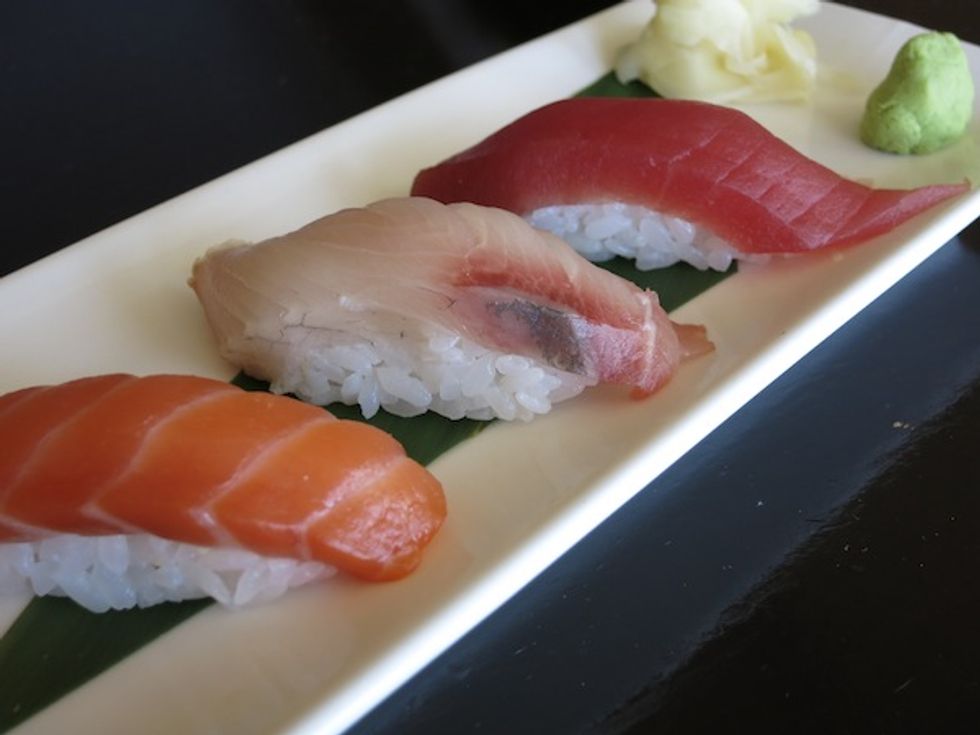“People eat sushi the same way they drink wine,” says Jason Kwon, executive chef and owner of Joshu-Ya Brasserie in Berkeley. “They know about it, but they don’t know about it.” San Francisco houses nearly 200 sushi bars where words like “unagi” and “hamachi” no longer require English translations. But even as diners have cultivated an appetite for raw scallops and octopus, many don’t know the etiquette for eating them. Do you stir wasabi into the soy sauce or spread it directly on the fish? What should you drink? Is it rude to eat it with your fingers?
The word “sushi” is usually associated with raw fish, but it actually refers to the vinegared rice, which can be topped with any variety of raw or cooked proteins or vegetables. While customers rarely drool over the rice, it’s actually the best indicator of the chef’s skill. The chef seasons his rice to complement the taste of the seafood. “The rice,” says Kwon, “shows his understanding of the fish.”
The diners show their understanding of sushi by demonstrating proper manners. The rules of eating it – how to hold, how to dip, and even how to place each piece in your mouth – are designed to make the food taste better.
Here are the do’s and don’ts:
Don’t rub your chopsticks
“In Japan, this action would be considered an embarrassment,” says Executive Chef Yuko Kajino of Chaya Brasserie. High-quality chopsticks don’t need to be rubbed to remove splinters.
Use your hands
Sushi originated as finger food, and it’s still perfectly acceptable to use your fingers. Kajino actually prefers it. “You are only supposed to dip a small portion of the fish side of nigiri in soy sauce and it is hard to properly dip the fish using chopsticks.
Don’t pour wasabi into your soy sauce
This a little controversial, but purists agree that you should not pour wasabi into the soy sauce because it dilutes the flavor of the wasabi. A good chef will have spread a little wasabi on the fish, but if you want extra, spread it directly on the fish. “Americans love the flavor of soy sauce and wasabi mixed together,” says Kajino. “As a result, many fish begin to have the same flavor particularly when you are dealing with the subtle taste difference amongst many delicate white fish.”
Dip your sushi fish side first
Avoid dipping your sushi rice into soy sauce for a few reasons. One, the rice is already seasoned. Two, it may soak up too much soy sauce and risk overpowering the fish. Three, you don’t want to pollute your soy sauce with fallen grains of rice.
Rice follows fish
It’s not enough to plop the entire piece in your mouth if you want to appreciate the delicate relationship between the fish and the rice. “When eating sushi traditionally,” says Kajino, “the nigiri should be put into your mouth with the fish facing your tongue and the rice facing the roof of your mouth so that you taste the fish more than you taste the rice.” With overstuffed rolls, however, you can tackle them any way like.
Eat from lightest to darkest
Start with the mildest fish, like fluke and flounder, and work toward the heavier tuna so that you don’t cloud your taste buds with the flavors of the stronger fish. If you order an omakase meal, the chef’s tasting menu, your sushi should progress from lightest to darkest.
Drink green tea
Traditionally, diners would not drink sake with sushi, because both are made from rice and thought to interfere with one another. Green tea doubles as a palate cleanser.
If any of the above rules start to give you a wasabi headache, disregard. They’re meant to enhance the experience. Even Chef Kwon, who disdains hot sake and maki admits, “I tell my customers to do whatever they want.”





















